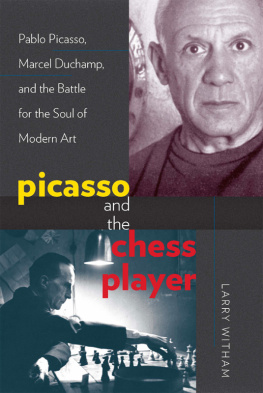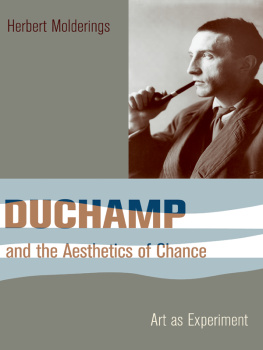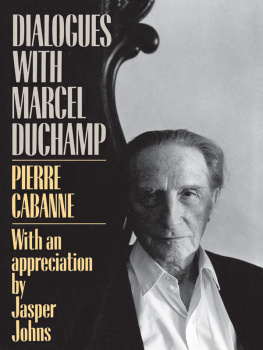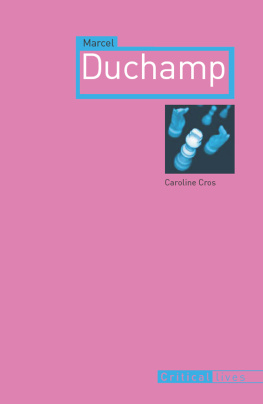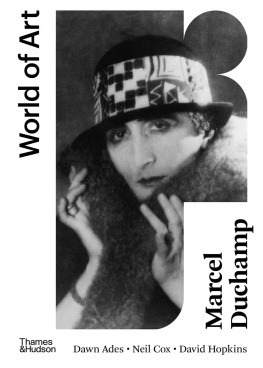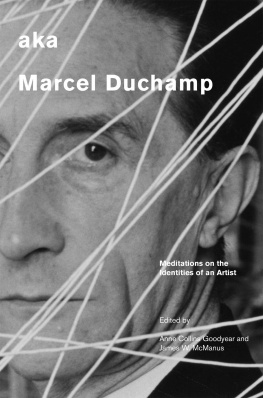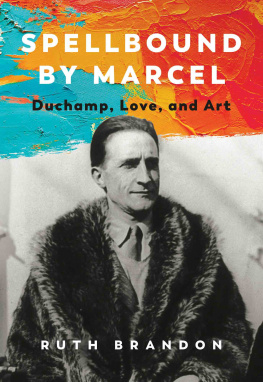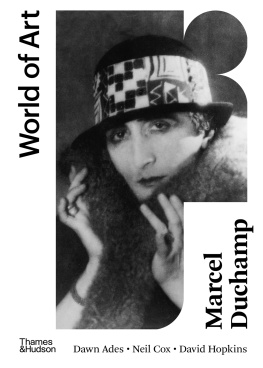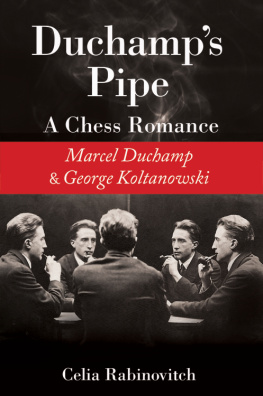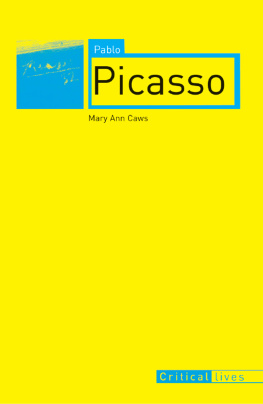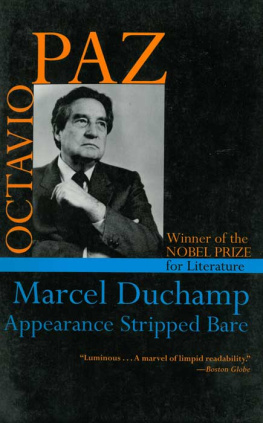University Press of New England
www.upne.com
2013 Larry Witham
All rights reserved
For permission to reproduce any of the material in this book, contact Permissions, University Press of New England, One Court Street, Suite 250, Lebanon NH 03766; or visit www.upne.com
Library of Congress Cataloging-in-Publication Data
Witham, Larry, 1952
Picasso and the chess player: Pablo Picasso, Marcel Duchamp, and the battle for the soul of modern art / by Larry Witham.1st [edition].
pages cm
Includes bibliographical references and index.
ISBN 978-1-61168-253-3 (cloth: alk. paper)
ISBN 978-1-61168-349-3 (ebook)
1. Picasso, Pablo, 18811973. 2. Duchamp, Marcel, 18871968.
3. ArtistsFranceBiography. 4. Picasso, Pablo, 18811973
Influence. 5. Duchamp, Marcel, 18871968Influence.
6. Modernism (Art) 7. Art, Modern20th century. I. Title.
ND553.P5W547 2013
709.2'2dc23 2012034380
[B]
If only we could pull out our brain and use only our eyes.
Pablo Picasso (18811973)
Painting should not be exclusively retinal or visual; it should have to do with the gray matter. That is why I took up chess.
Marcel Duchamp (18871968)
1 sensation of sensations
On the wintry streets of Manhattan, the foot traffic to see the greatest art exhibition in America had been discouragingly slow. The 1913 Armory Show had opened on February 17. It had begun with a gala party, a band, and speeches. The unveiling of provocative Parisian art followed. The newspapers had trumpeted the exhibit opening, but even so, the public was not coming. Then something changed. By the second week crowds began to flock. The public had caught wind of what one newspaper called a sensation of sensations. It was a single painting among nearly 1,300 canvases and sculptures.
The sensation of sensations was a Cubist painting of a fractured figure moving down a stair, a picture that was given its greatest allure by the title, Nude Descending a Staircase. No one really noticed the name of the French artist. He was twenty-five-year-old Marcel Duchamp, who at that time was back in Paris, oblivious to all the Manhattan uproar. The Nude hung in the same space, Gallery I, as did a so-so Cubist painting, Woman with a Mustard Pot, by a slightly better known Pablo Picasso. The foreign names did not matter as much for the American public as the avant-gardes sheer bravado in this new modern art, filled with its apparent jokes and breach of cultural etiquette. For Americans, this was exactly what was to be expected from the wild men of Paris.
By the measure of controversy, Duchamps Nude was a crowd pleaser, apparently worthy of national attention. The image was not obviously a nude, or even a man or woman, but a human-like figure, a splintery wooden skeleton, coming down a stair as if twenty separate snap shots were overlapped. For a young artist like Duchamp, it was a striking and innovative work. It was his first chance to outshine Picasso and, in that sense, the Armory Show was also the first competitive encounter between the life and work of the two artists. By public acclaim, in this round, Duchamp came out the winner. The splintering Nude established Duchamps foothold in America.
The exhibition was held at the Sixty-ninth Regiment Armory building On the outside of the fortress-like building hung a banner reading, International Exhibition: Modern Art. The inside was partitioned by themes and decorated with bright bunting and yellow streamers, dull burlap, potted plants, and hanging green garlands. The so-called Cubist Room was at the back of the gauntlet of spaces, a place that the newspapers, tongue in cheek, called the Chamber of Horrors. At the center of this chamber was Nude Descending a Staircase, described by one critic as an explosion in a shingle factory, and parodied in another newspaper as The Rude Descending a Staircase, a cartoon about chaos on a subway stair.
The great exhibition also featured European painters from Francisco Goya up to the Impressionists and beyond, making it an object lesson on art, worthy of serious reviews as well. However, the Armory was at heart a mass-media event, geared to drawing crowds, selling tickets, and titillating the public. With its publicity in the hands of a seasoned newspaperman, the exhibit sent press releases nationwide and modern art postcards flooded New York (including a postcard of Duchamps Nude). Newsrooms around the country were mailed an Armory Show press photo, indeed a photograph of, yet again, Marcel Duchamp, who is shown with two brothers, also artists in France.
The International Exhibition of Modern Art, for all of its circus atmosphere, marked a turning point in American awareness of modern artthe Armory Show was the first major importation of the new things happening in Europe, where a movement recently dubbed Cubism had emerged. One of the New York exhibitions central goals had been to promote American artists by putting them alongside their European forebears, a plan that somewhat backfired. Although the Armory Show marked the start of serious collecting of modern art in the United States, the American painters and sculptors ended up disappointed. The Europeans received the publicity and sold most of the artwork.
The import of the European avant-garde to New York City had set an important precedent nevertheless, for in future decades, the hub of modern art and the modern art museum would shift to Manhattan. Through the Armory Show, Duchamp had gained an early toehold. Although few people remembered his name, Nude Descending a Staircase became an icon of American popular culture, a story of the Parisian in America (and eventually, a Parisian who would become a US citizen). By no intention of

AFTER THE ARMORY SHOW ran its course from February to March 1913 in New York City, it traveled to Chicago and Boston. In the entire period before, during, and after the show, Picasso and Duchamp were thousands of miles away. In late 1912, a small group of Americans had hurried through Paris, borrowing works by Picasso and Duchamp for the Armory Show, but neither of the artists was around for that moment of contact. During those months, Picasso was busy enough. By turns he was on the coast of southern France innovating synthetic Cubism, then moving his studio in Paris, and then traveling to Barcelona for his fathers funeral.
Picasso was a young Spaniard in a hurry, the wafting smell of oil paint always around him, a cigarette forever in his fingersand soon a pipe with fine tobacco, as his income from selling paintings was getting better. His dark hair bobbed over his forehead, and his dark eyes were hypnotic enough to be noticed.
Duchamp could not have been more different, and during the period of the Armory Show, Duchamp was in a far different state of mind than that of Picasso. To get out of stifling Paris, he had just spent several weeks in Munich by himself, and it was a life-changing experience. After Munich he toured Europe to see its art museums; it was only a taste of his future, because he would soon become a traveler, often living out of a suitcase for long periods. On this trip, Duchamp had returned to Paris by the end of 1912, questioning his life as an artist, and mostly holing up in a suburban studio, going out on the town with a raucous, well-heeled friend.
Incessantly, he puffed on a pipe, adding a bit of professorial panache to his otherwise youthful visage (and when he had money in the future, Duchamp preferred chain-smoking Cuban cigars). As a painter, though, Duchamp hated the smell of oil paint. So as an alternative, he began making plans to put his next major art project on a gigantic piece of glass. It would be a hilarious but also intellectual piece, one day to be called

